The Harbin, China Snow & Ice Festival
January 23, 2012
Aside from the wedding in Beijing, the highlight of our trip to China was a brief overnight visit to the city of Harbin in northeast China. Harbin is home to the Harbin International Snow & Ice Festival, the largest winter carnival in the world. The 2012 Festival started on January 5, so we traveled 2 hours north of Beijing to see the enormous snow and ice sculptures that are the hallmark of the event.
We left Beijing the morning after the wedding for an easy 2-hour flight on luxurious Air China (Note the sarcasm. How this airline is a member of the Star Alliance is beyond me). We planned on seeing the Ice Festival, the Snow Festival and the downtown Ice Sculpture contest in about a day and a half, so we didn't need to stay long. It's rare that the two of us travel with more than two suitcases, but on this trip there was a third full of winter gear.
Before planning this trip, I had never heard of Harbin, but it's the tenth most populous city in China with nearly 11 million residents. For most of its history, Harbin was part of Russia, and after World War 2 and the Japanese occupation, it was home to the largest Russian population outside of the Soviet Union. After the Soviet army liberated the city, it was turned over to the Chinese and the Russian population was either repatriated back to the USSR (not a joyous event, by the way, as many had fled the communists), or migrated on to Shanghai and other parts south. Today the Russian influence can very much be seen in the local architecture, cuisine and the arts.
Harbin sits adjacent to the Russian border along Siberia, and fittingly the winters are long and brutally cold. The temperatures drop below freezing in October, and seldom rise above freezing until well into March and even April. The average temperature for January is 24 degrees below zero. I suppose city leaders looked at ways to draw tourists and decided to capitalize on the one thing the city has going for it: extreme cold. They city began hosting ice-carving contests in the 1960s, and added other winter activities over time. Other than a few years during the Cultural Revolution, when the country was too busy purging and persecuting, the festival has been held every year since 1985 and has grown in scale and attendance each year.
The original ice-carving contests were held in the city's Zhaolin Park. Sculptures were surpassed by giant ice structures as the main attraction, and eventually the festival moved to the city's outskirts where it could freely grow in size.
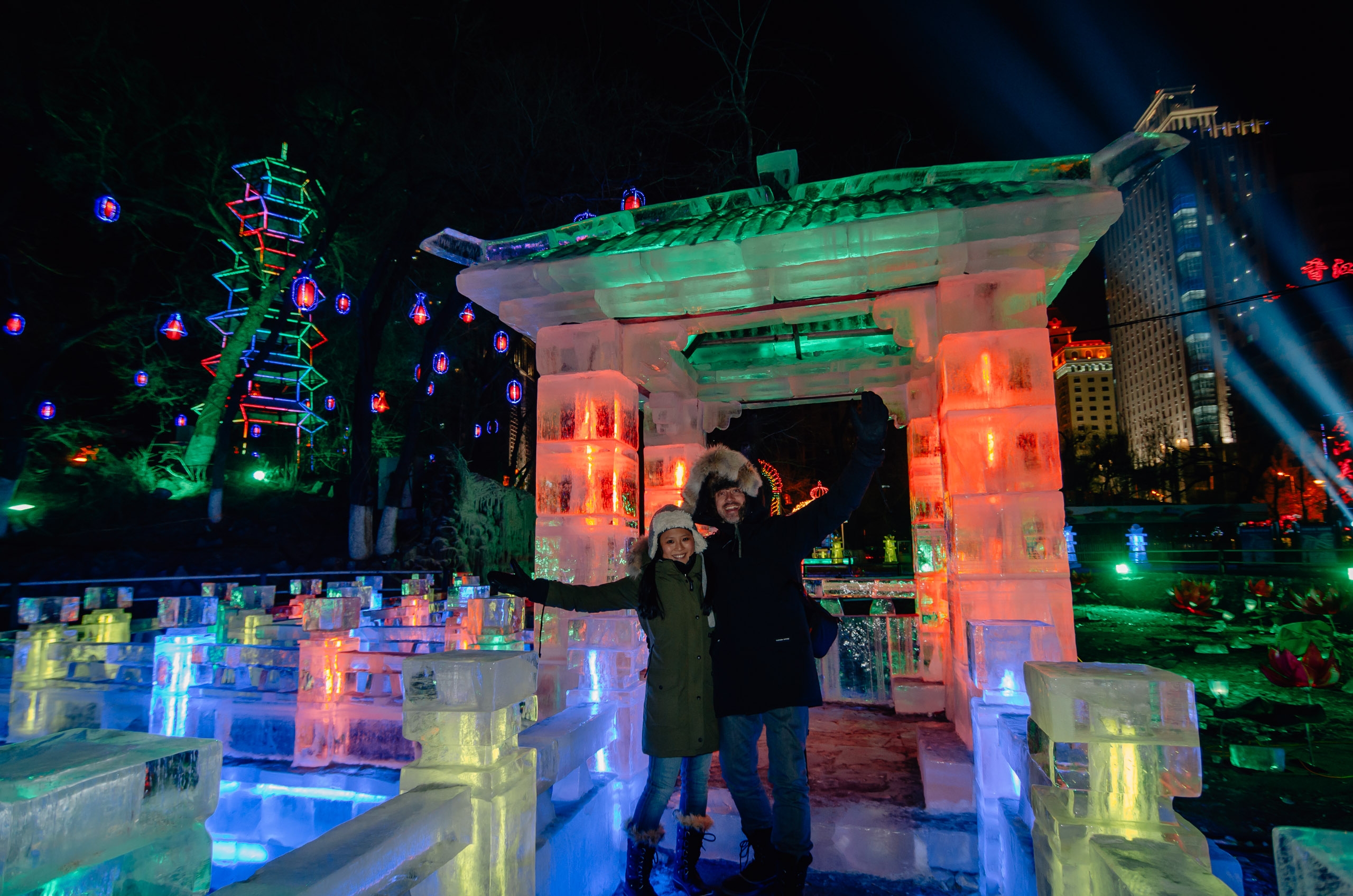
Inside Zhaolin Park in Downtown Harbin
As the ice structures were built larger and larger, they were illuminated from within first by fluorescent bulbs but today mostly by colored LEDs that change hue at random. It's much cheaper to attend the festival during the day, but the attractions aren't that interesting without the lights.
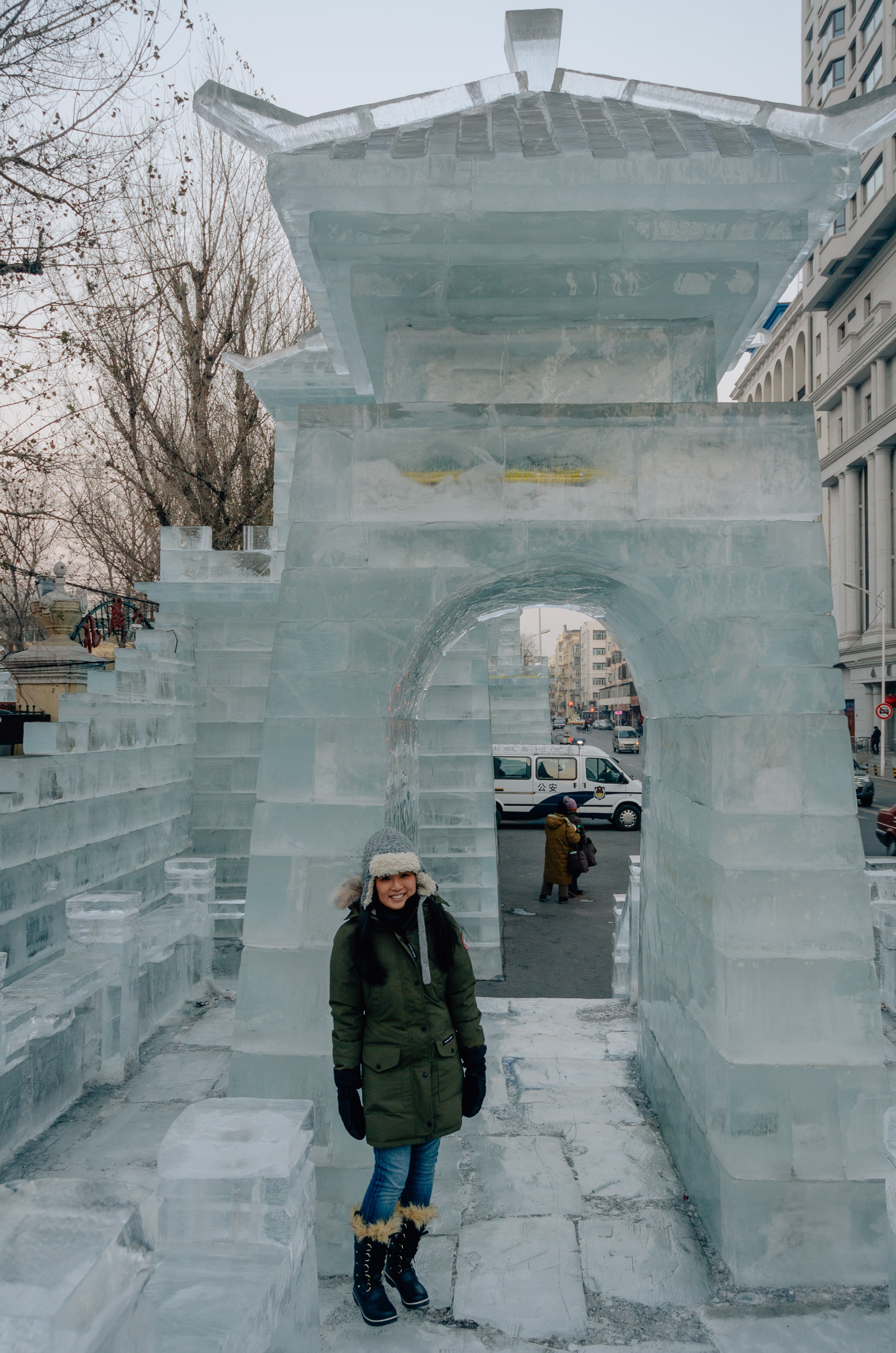
The ice structures during the day are not much to look at
After checking into our hotel, had a hasty lunch of so-so regional Chinese food and headed downtown to see the sculptures in Zhaolin Park. Arriving at the gate, it never occurred to us that we would need to buy a ticket, and the tickets (by Chinese standards) were a bit pricey at 400RMB per person (about $37USD). Luckily, there was a Bank of China ATM nearby so we got our ticket and headed inside.
The sun sets around 3:15 in January, so it was already quickly getting dark and the temperature was hovering just around zero. Once inside the park, I started to get a few slight pangs of regret. There was lots of ice and lights, but none of it terribly impressive. It looked like a sad, run down carnival that had lived far past its prime.
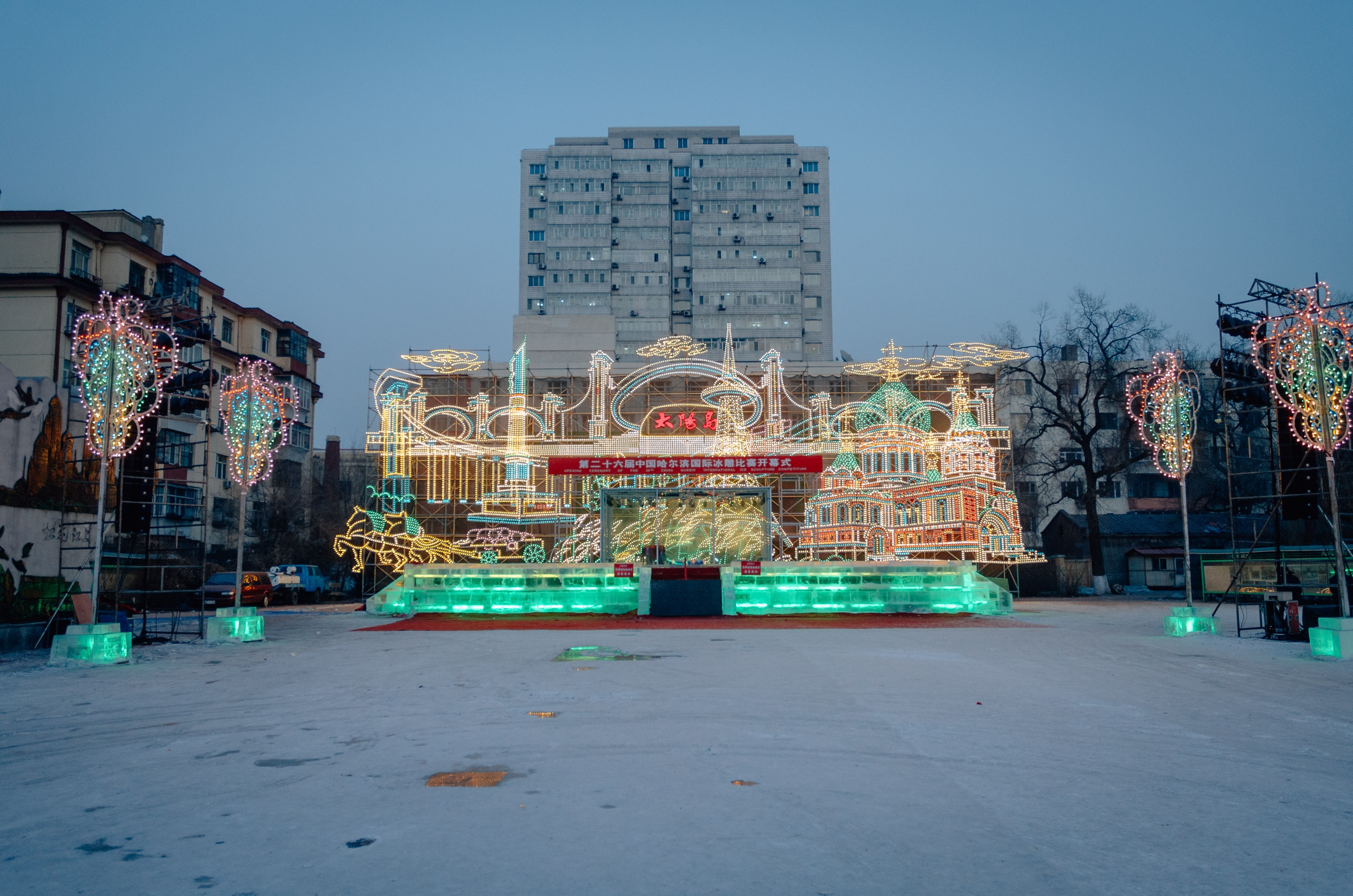
The Soviet-era snow and light spectacular in downtown Harbin
Once it got dark enough, the ice and lights became more impressive. We walked the park in its entirety, posing for a few photos along the way before finally stopping at a warming hut to hopefully raise our temperatures.
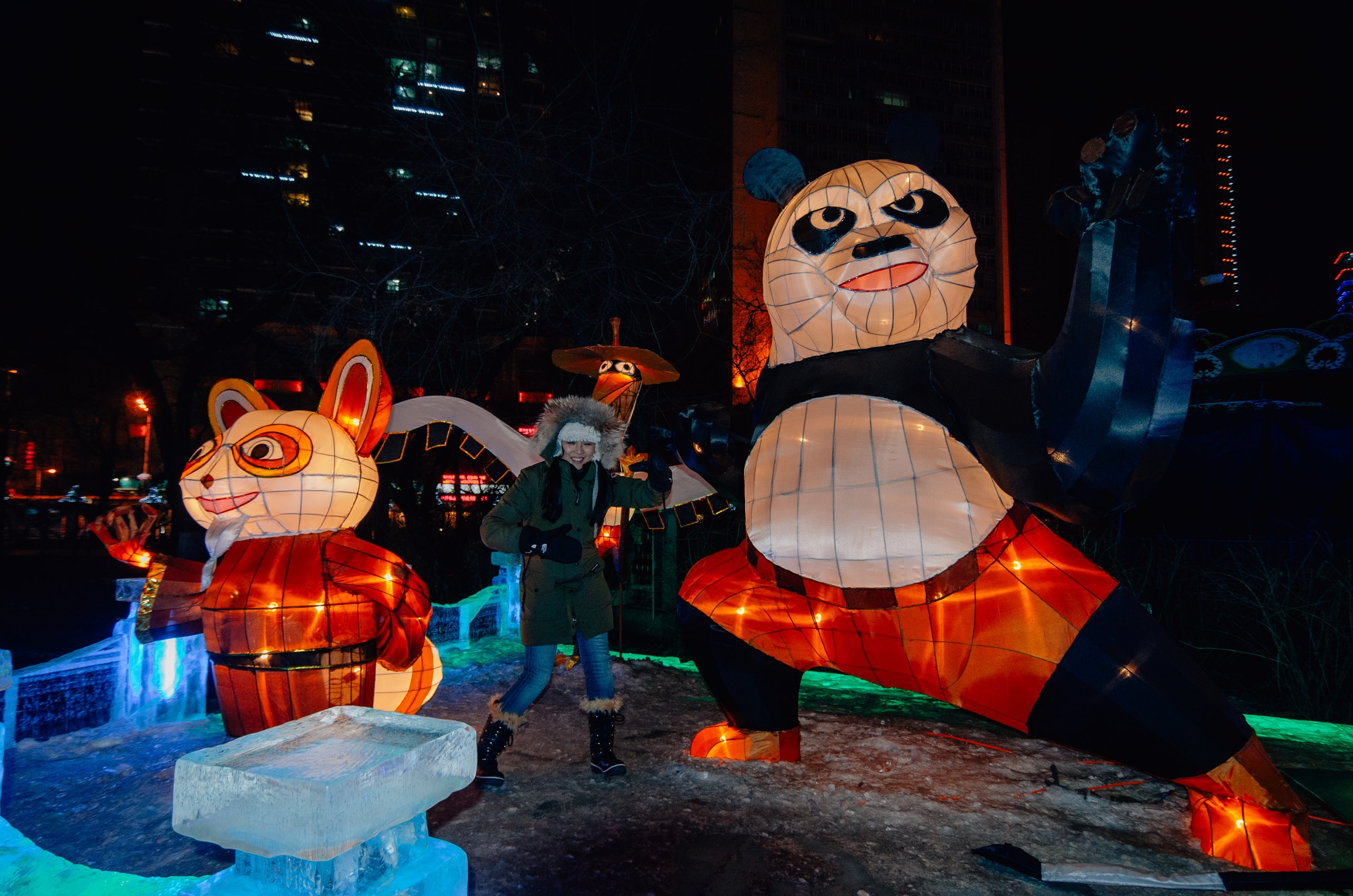
Jessica amidst a surely-licensed Kung Fu Panda display in downtown Harbin
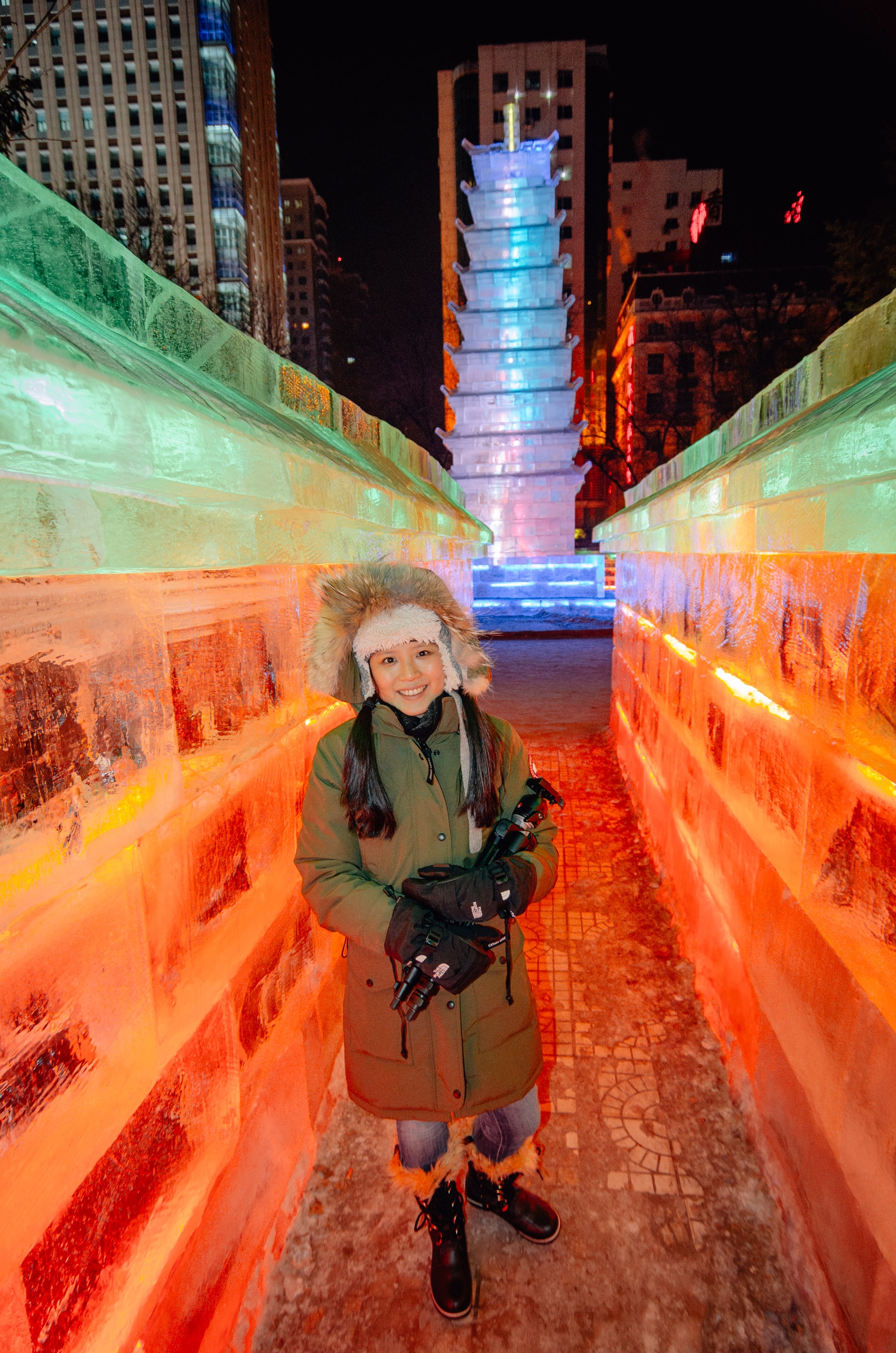
The tallest ice pagoda in downtown Harbin
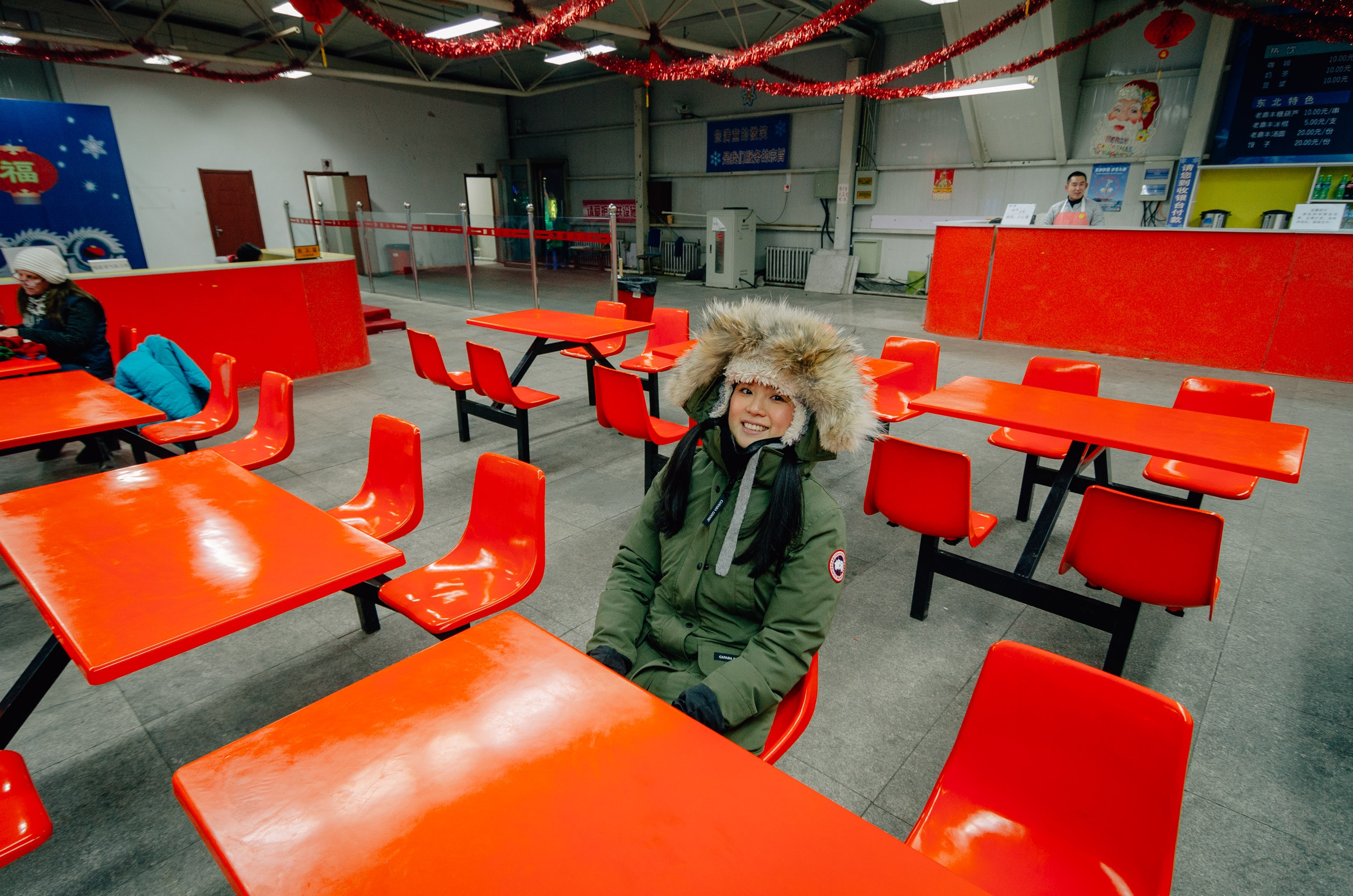
The nearly-deserted warming hut in downtown Harbin. To be fair, it was pretty early
Around 5:30, we caught a taxi (Actually, we stole it from someone else which is the only way to get a taxi in China) and headed over to the Ice Festival outside of town. Taxis in China are a challenge even for a fluent Mandarin speaker (by the way, that would not be me). Scams are frequent, but communicating directions is the hardest. The hotel indicated we'd have no trouble getting a taxi back from the Ice Festival, but they failed to mention that we'd have to haggle thoroughly and in the end we'd like get ripped off. For context, when I say "ripped off", we paid about $10USD for our cab ride back to the hotel, an enormous sum for cab fare and about ten times the metered rate. I didn't mind the price so much as getting screwed.
We arrived at the Ice Festival a little before 6:00PM. By then it had been dark for hours, and being outside the city, the temperatures were around -15 degrees. Tickets were 400RMB apiece (about $60USD), wildly expensive by local standards. Once inside the fair grounds, you're immediately struck by the scale and enormity of the structures built entirely from ice.
Harbin China Ice Festival - 2012-0108-DSC_2087_96799
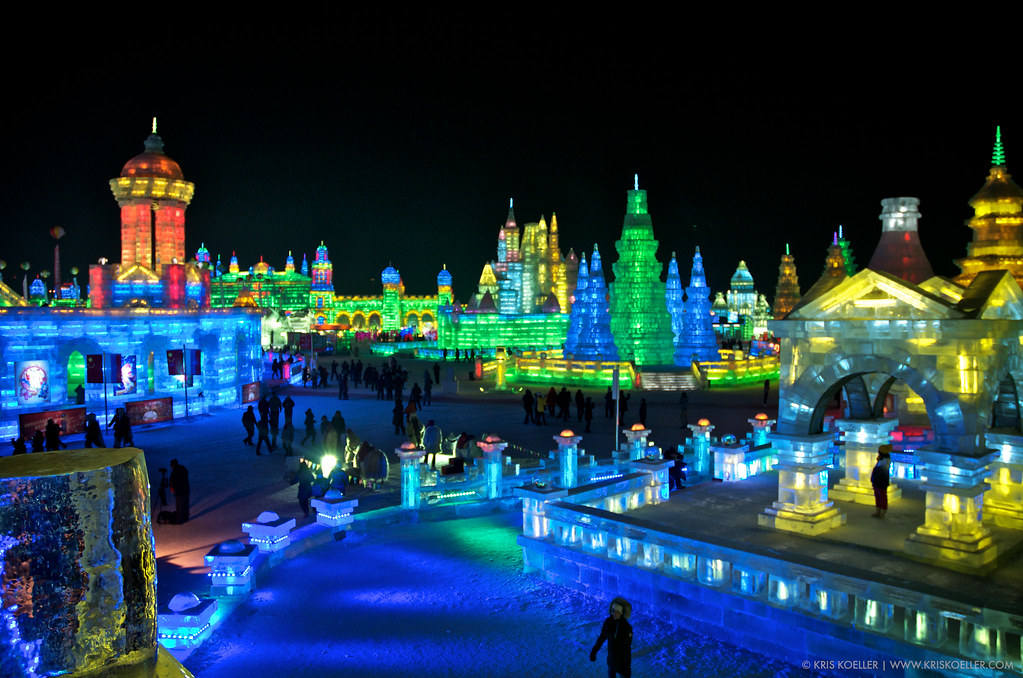
The mind-blowing City of Ice at the Harbin Ice Festival

The City of Ice at the Harbin Ice Festival
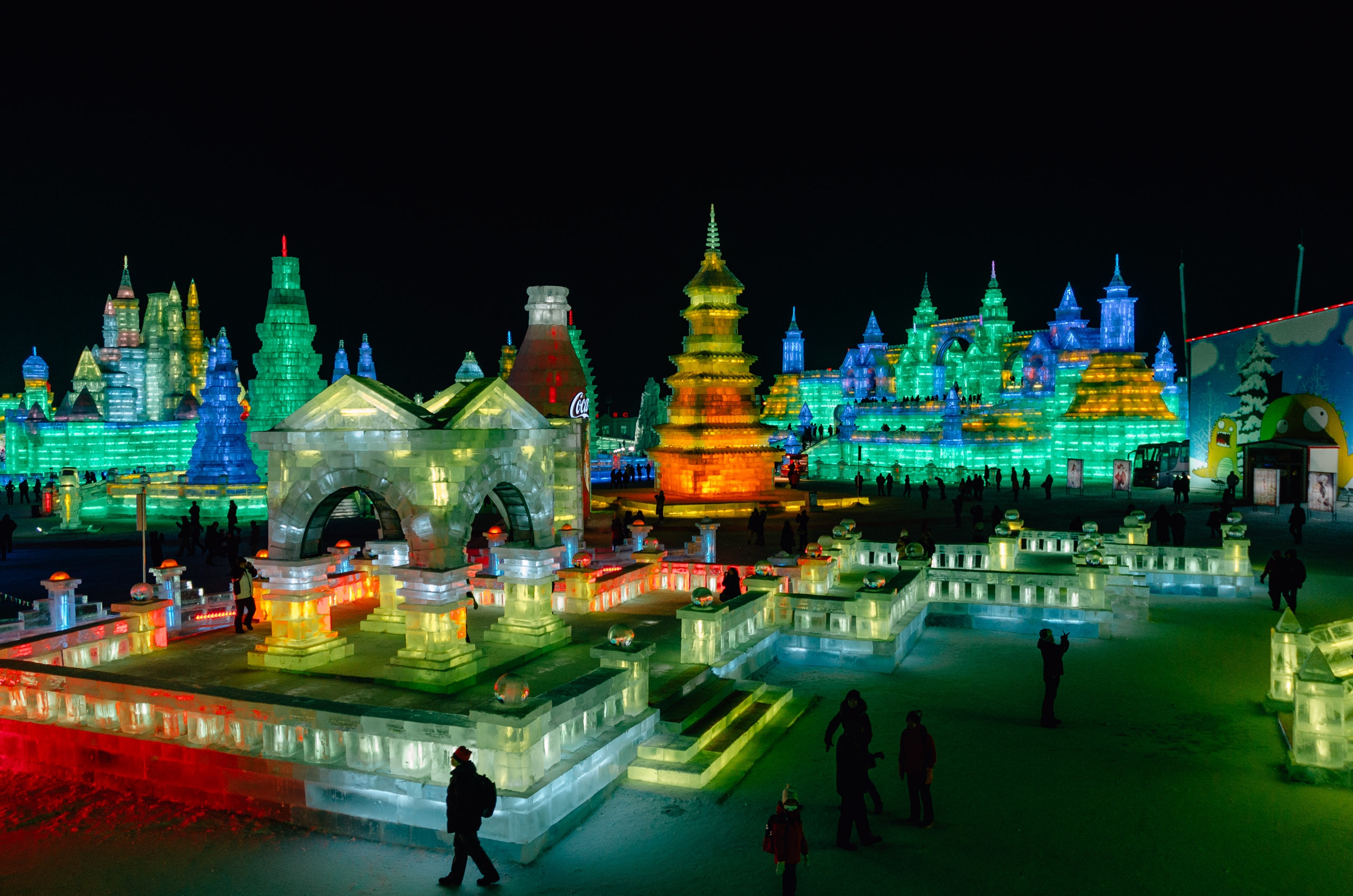
The City of Ice at the Harbin Ice Festival
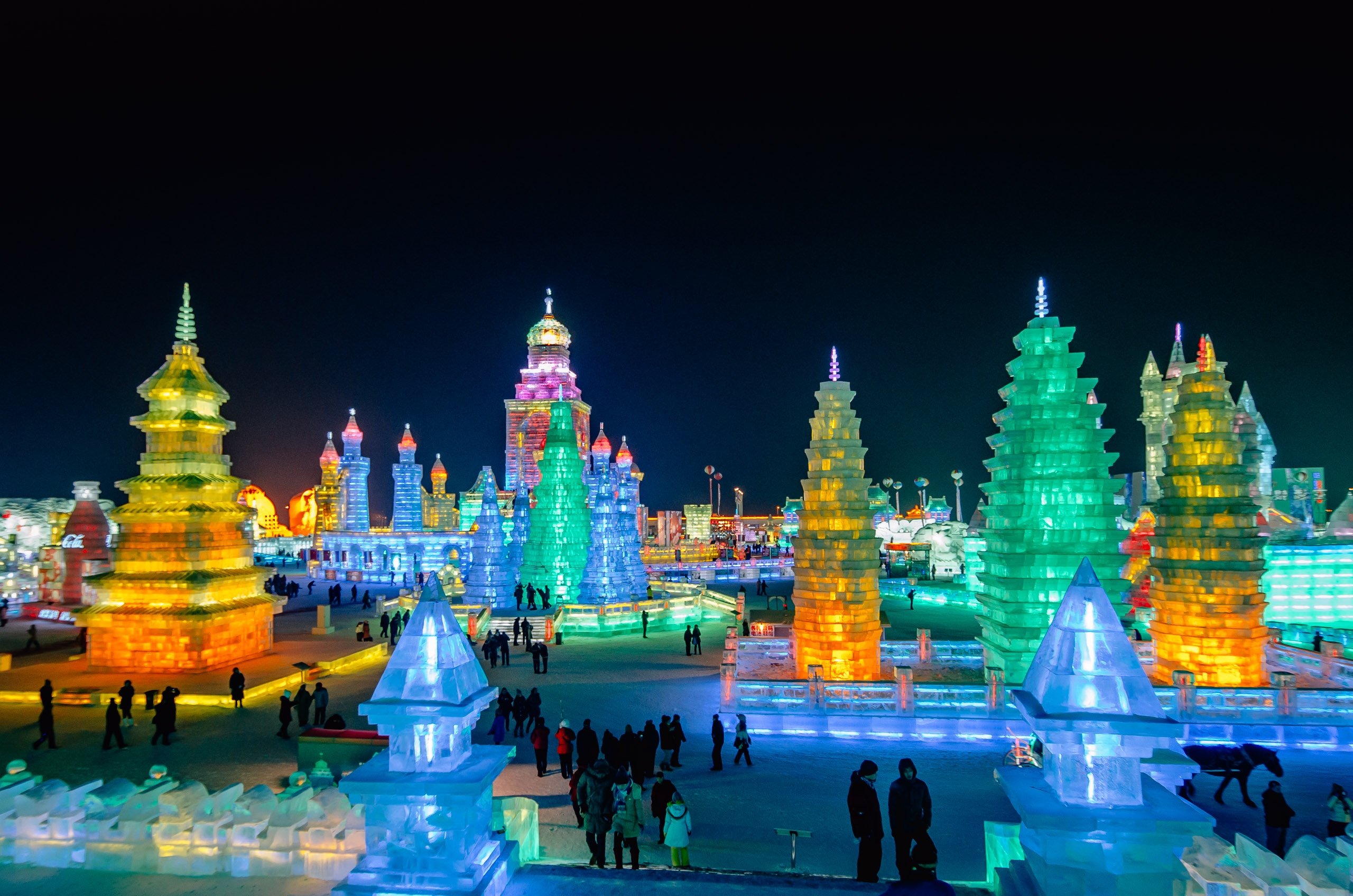
The City of Ice at the Harbin Ice Festival
We walked around the grounds for about a half hour simply in awe. Eventually, we got more adventurous and climbed up inside a few of the castles. Stairs made from ice were covered by carpets for traction, but you couldn't help but feel like the entire affair was inherently dangerous. Nonetheless, the viewing platforms rose 50-75 feet in some places. We stopped and watched a really bad performance by some uncomfortably cold "dancers", but mostly kept moving so we didn't freeze in place. Officially the festival runs through February, but will stay open longer "weather permitting." We interpreted this to mean "until the first melting ice-related fatality occurs".
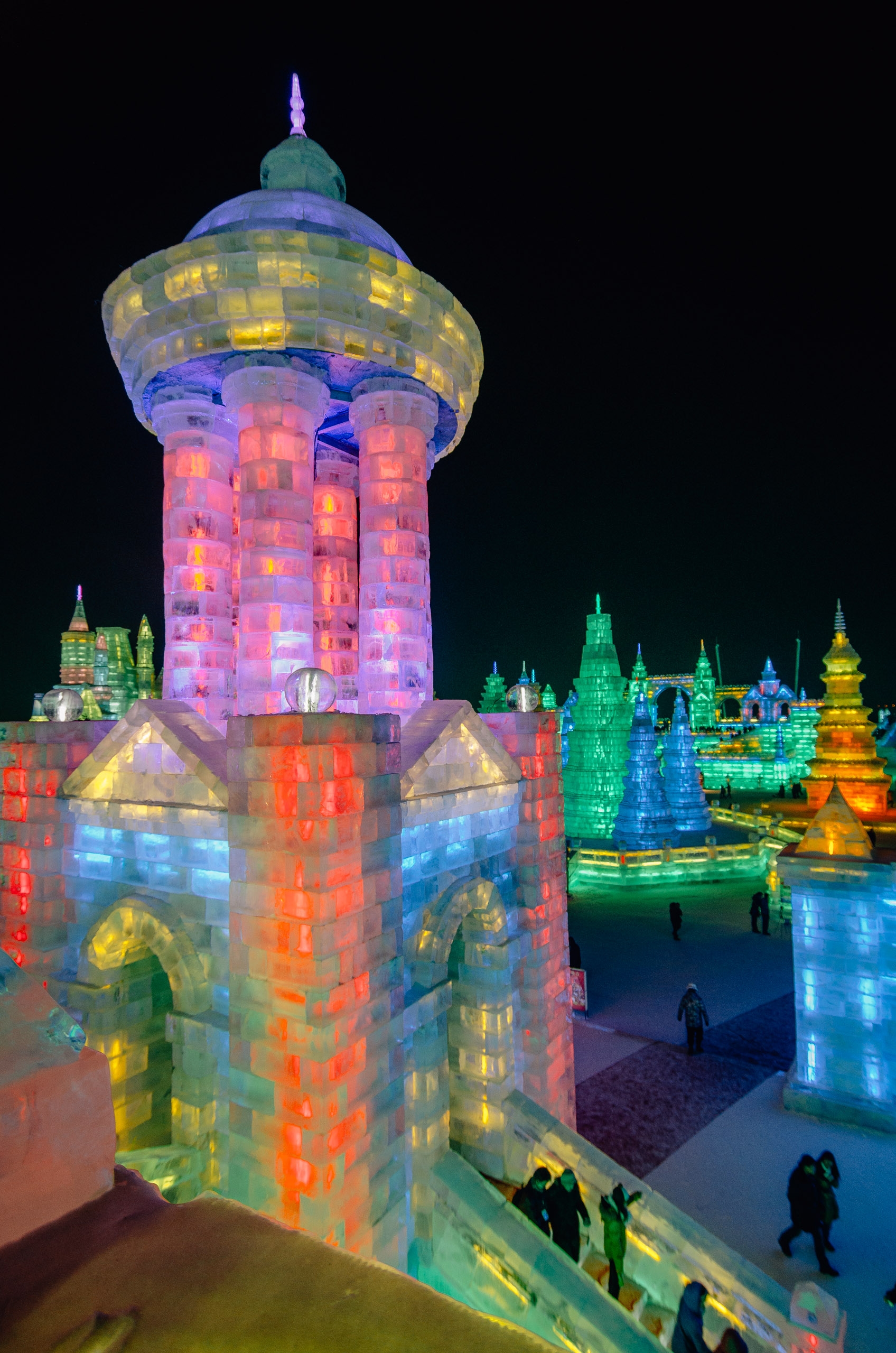
The City of Ice at the Harbin Ice Festival
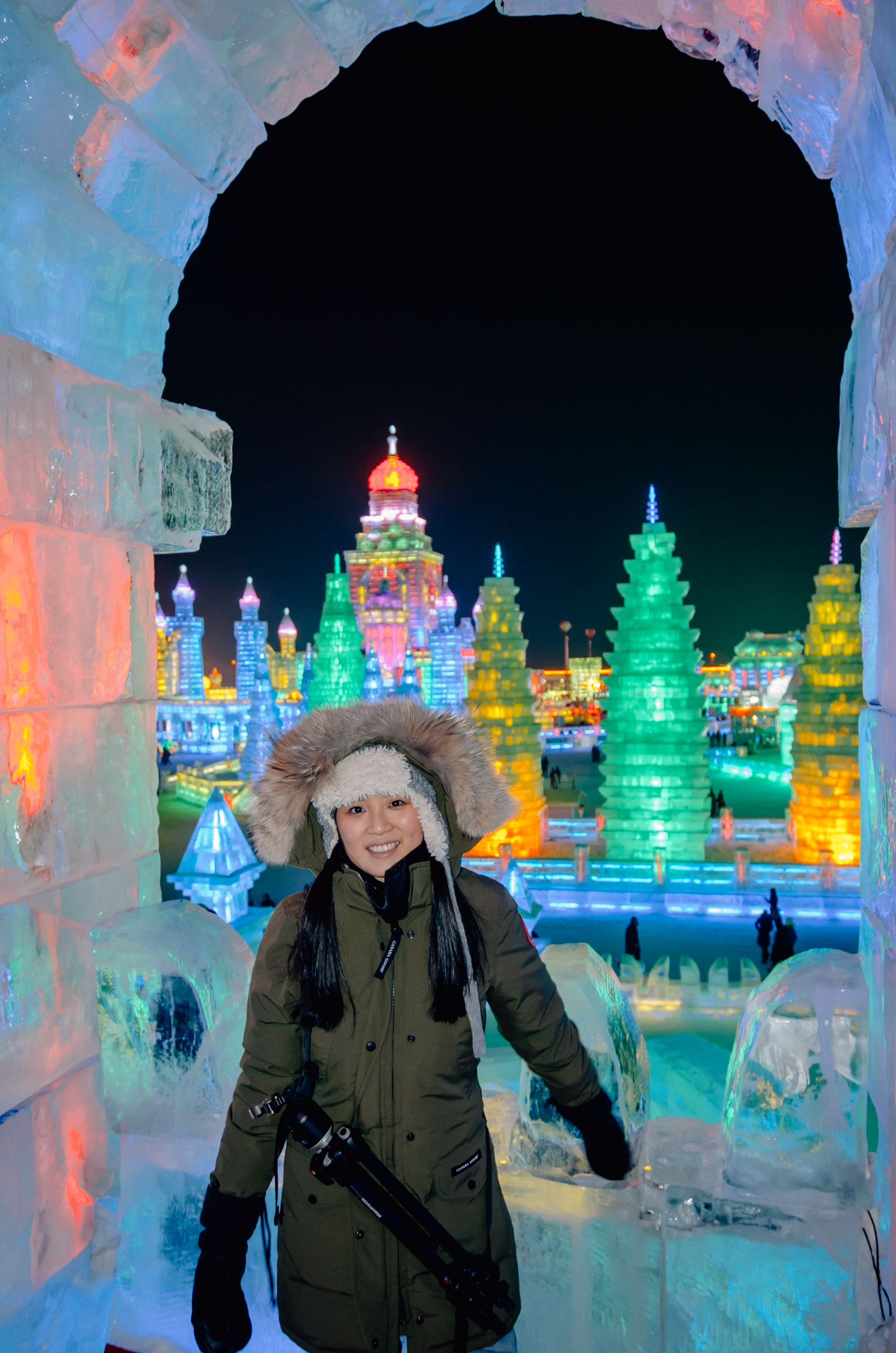
Jessica inside one of the ice turrets overlooking the Ice City
After an hour or so, we took a break inside one of the warming huts, where they served hot tea or warm beer. Harbin Beer was one of the event's key sponsors, so of course we ordered a Harbin, served slightly warmer than room temperature (normal room temperature). Given the conditions, it was actually pretty good. You really didn't mind that it was warm, and for an obscure Chinese beer, I rather liked it.
I took my camera out to warm it up, but that was a mistake as the humidity of the warming hut immediately froze into ice on the surface of us, our clothing and the camera. Nikon only rates their equipment to zero degrees, though I read online about people using them down to around -50. I kept my camera in a camera bag with a couple of handwarmers, and kept the batteries in my inside pocket close to my body. This seemed to help, but I could tell that as the evening went on, the focus of the photos got softer and softer. A DSLR is still a mostly mechanical piece of equipment, and electric motors, gears, lubricants and batteries simply can't perform well in those conditions. My iPhone, which I kept in my pocket, seemed to do fine, as did our all-digital point-and-shoot. I took the photo below while waiting for the lens to slowly defog.
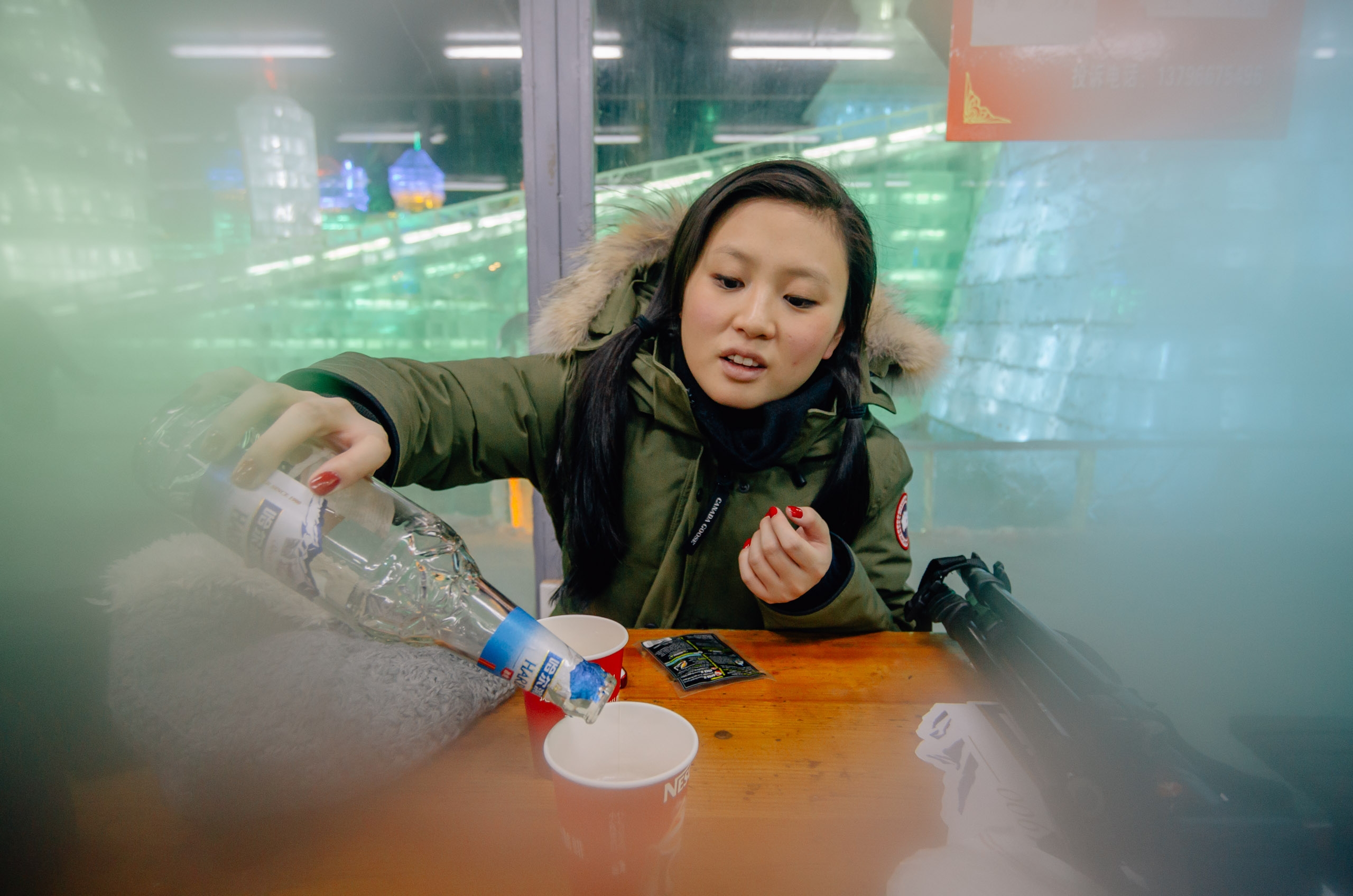
A welcome warm beer in the Ice City warming hut
While in the warming hut, Jessica could not help noticing the slide behind us and of course took it for a spin. I opted to photograph the event rather than participate. I tried a similar slide in Zhaolin Park earlier, and nearly busted my kneecaps when falling on the ice (there's video, stay tuned).
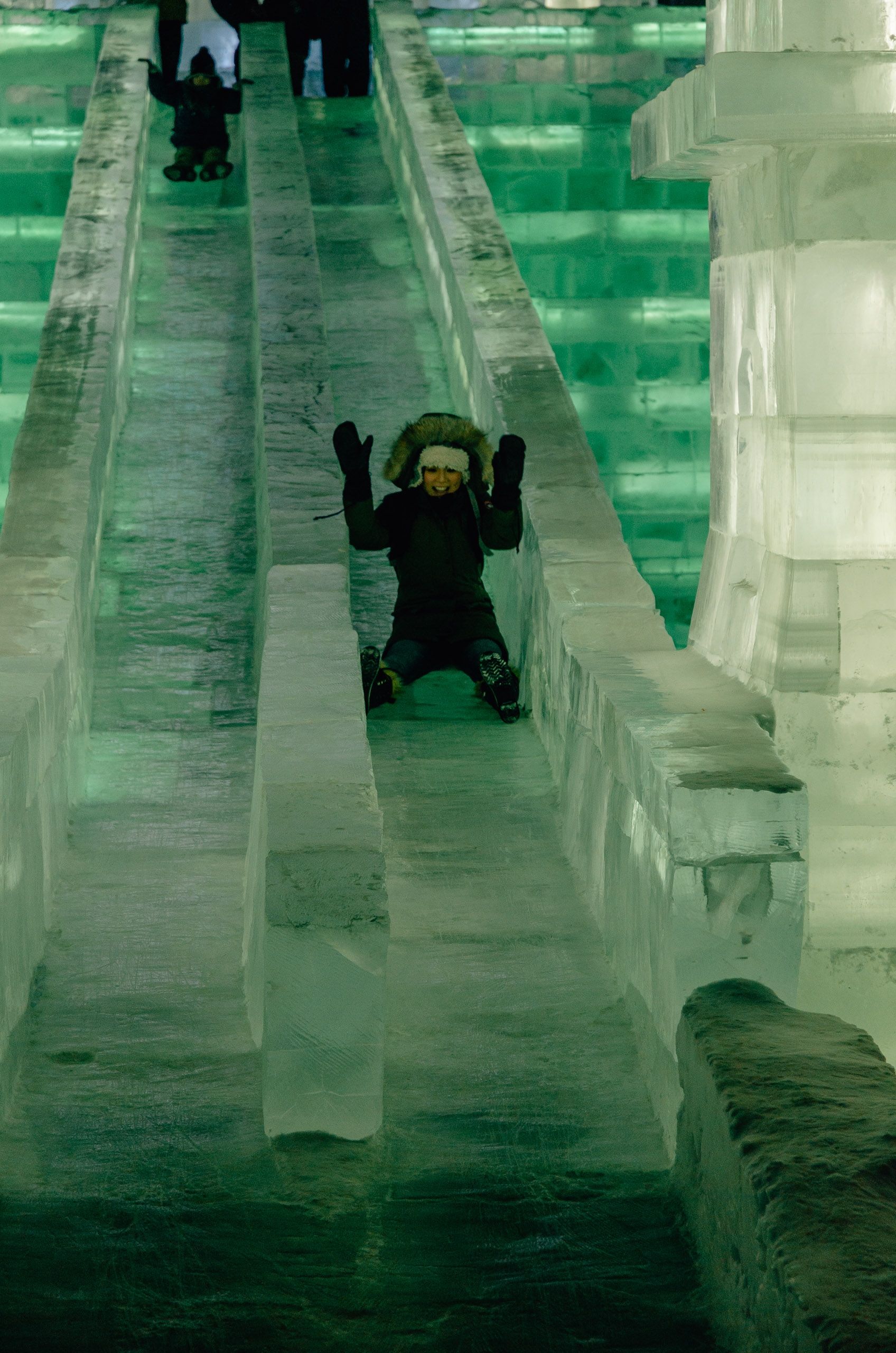
Jessica rides the ice slide
Although less of a draw, the sculptures are quite impressive. Some are made from giants blocks of compressed snow, while most are made from enormous blocks of ice. Traditionally, the ice was cut from the nearby river, but today they use specially-made ice form ionized water which is exceptionally clear and strong. Sculptors start with a chainsaw, and eventually use lasers for the more intricate detail.
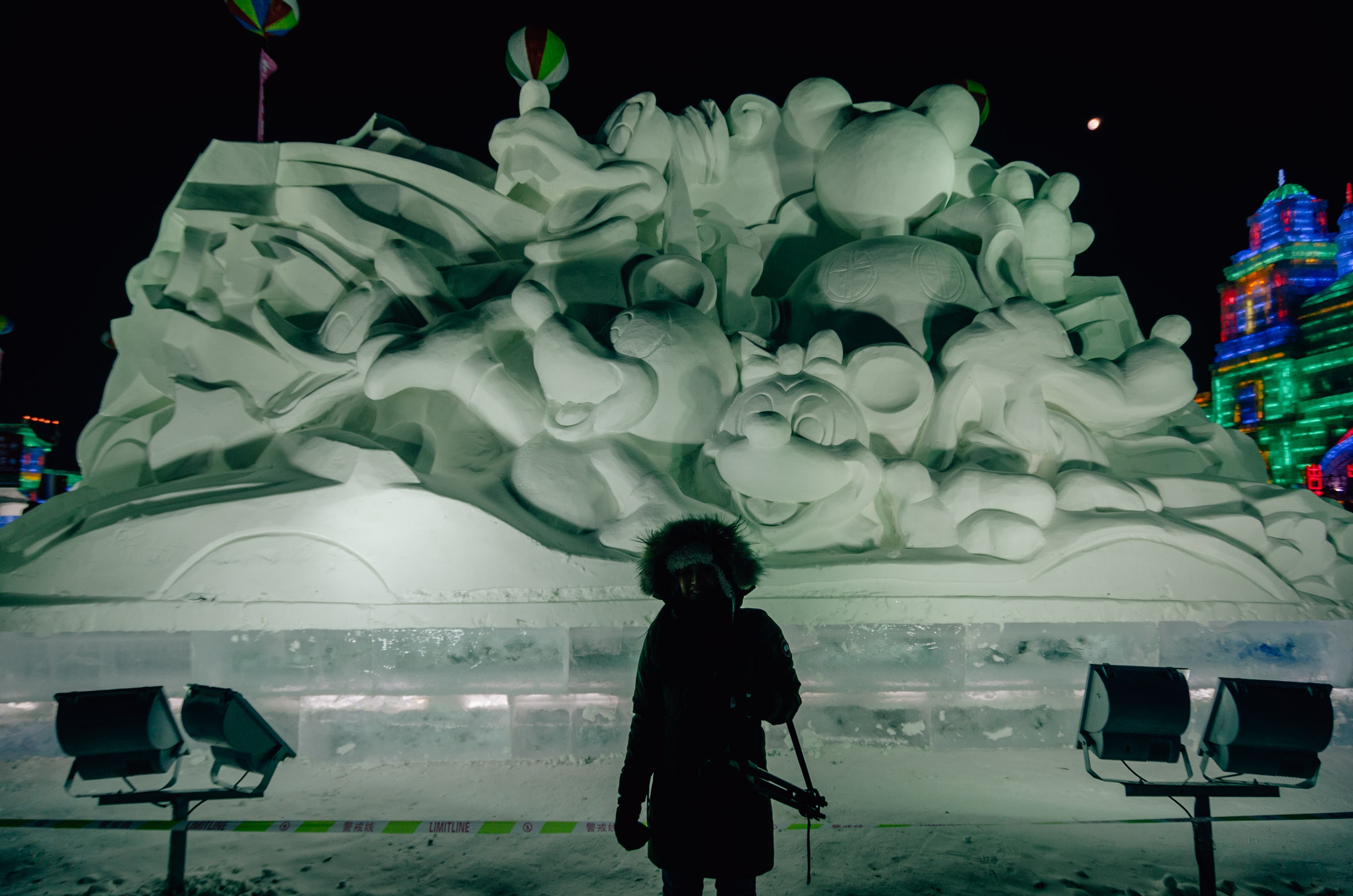
A Disney-inspired snow sculpture

A Year-of-the-Dragon ice sculpture
After about 90 minutes, we decided to head back to the hotel. By now, the cold was really taking its toll. Despite the impressive amount of high tech gear, the cold seeps in and it really does wear you down. We finally negotiated a taxi ride and got back to the hotel around 7:45. That night we had reservations at the hotel's Ice Palace Hot Pot restaurant, so we only had about a half hour before suiting up again and heading back outside for dinner.
The restaurant sits behind the hotel and is entirely made from blocks of ice. Obviously, the restaurant is not heated, and when we sat down for dinner it was approaching 20 below zero. Each of us had our own hot pot, and the uncooked food was brought to our table where it promptly froze. The steam from our hot pots would rise into the air, freeze and fall back on the table as snow. I couldn't drink my beer fast enough as it was freezing to the inside my glass. This experience may sound miserable, and while it wasn't exactly comfortable, the food was terrific and I'm glad we made the effort. We left dinner a bit sooner than we might otherwise, but by then it was time to get inside and stay inside.
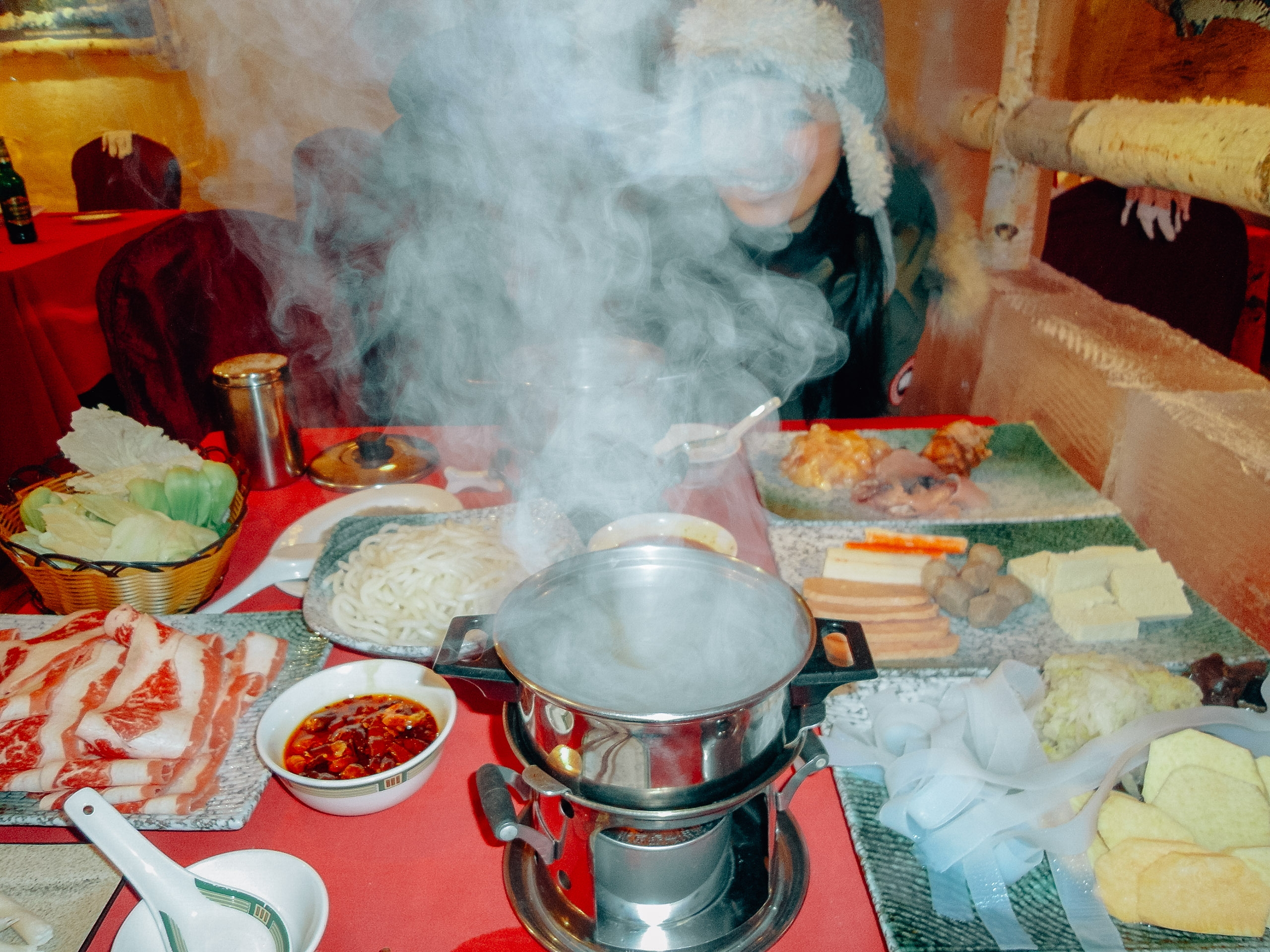
Jessica amidst the bountiful spread of the Ice Palace Hot Pot
The next day we traveled out to the Snow Festival to see the giant snow sculptures. It was slightly warmer during the day, but the temperatures still didn't rise above -5 degrees. While the snow sculptures are big and well-done, they didn't impress as much as the ice structures we saw the night before. Each year the snow sculptures have a theme, and this year's theme had something to do with Russia, as all the signs were in Russian and the scenes were either Russian or Marxist or both. Perhaps the Chinese aren't aware, but even the Soviets walked away from all that in the 1990s.
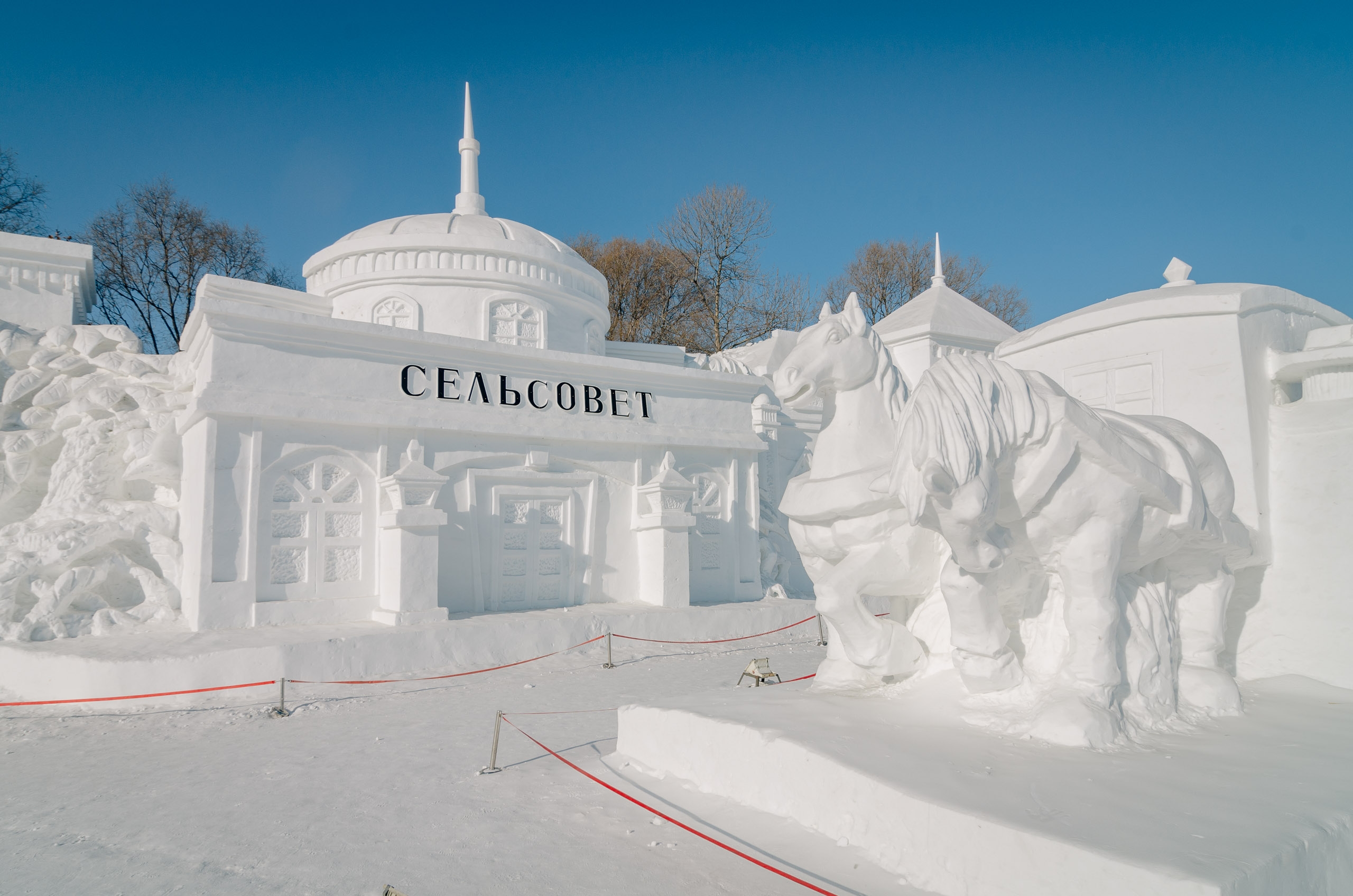
A Russian town carved from blocks of snow
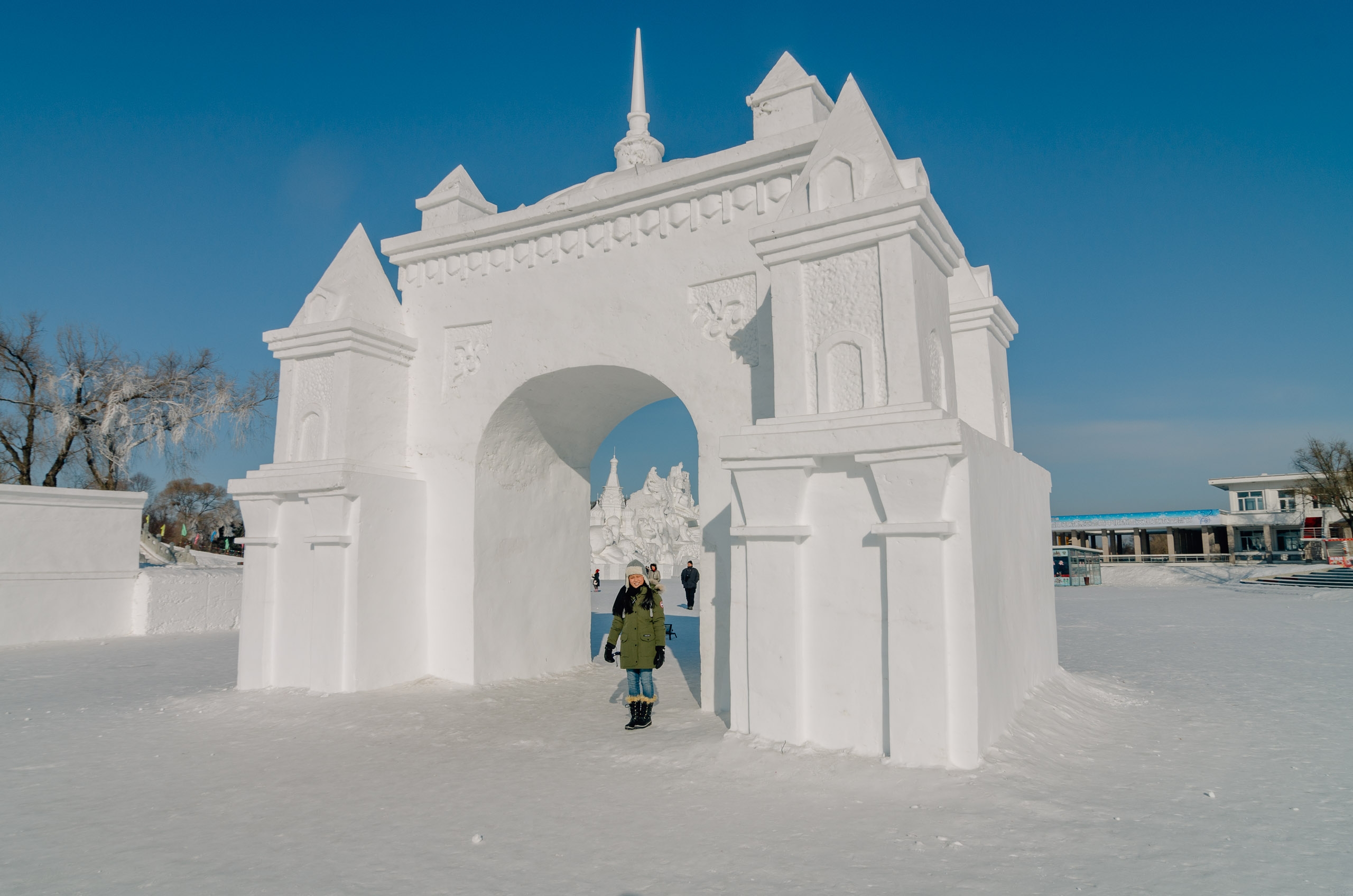
Me and Jessica under the Snow Arch
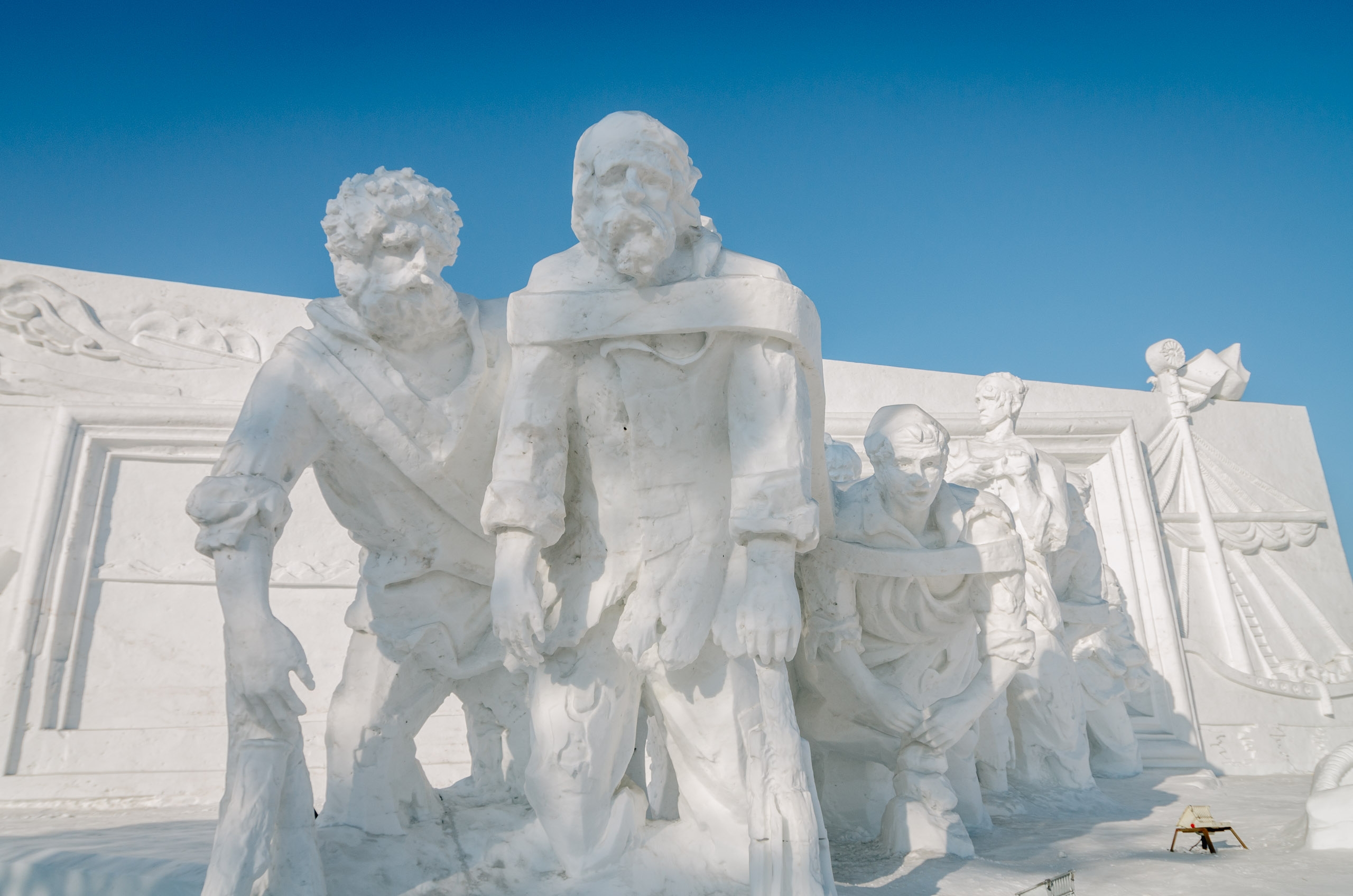
One of the Marxist-themed snow sculptures. So festive!
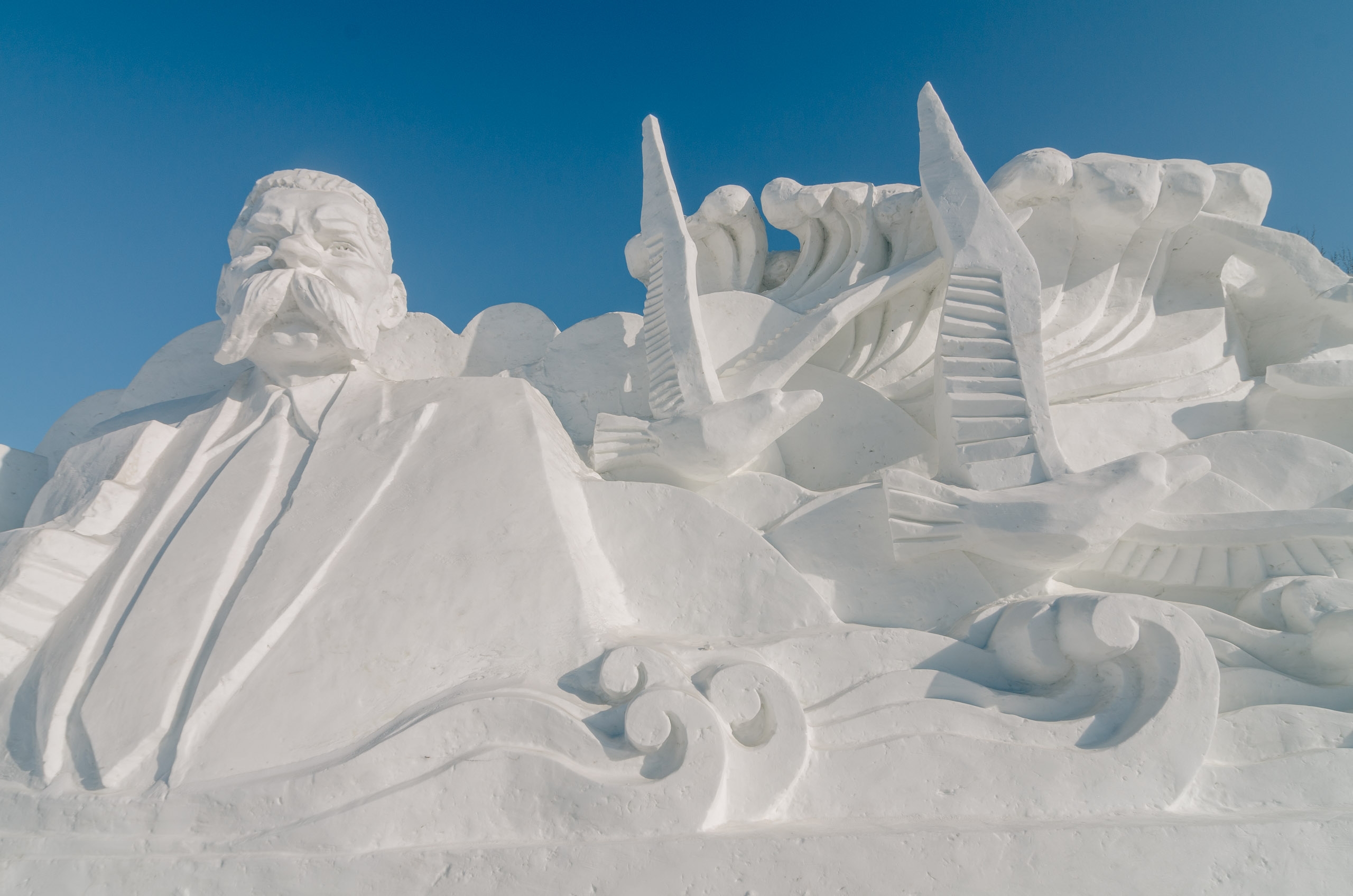
Another joyless snow sculpture
We ran into a couple from Los Angeles that were traveling in the region and had made a similar "24 hour" stop in Harbin. They snapped our photo, we did the same for them, then everyone scurried back to the hotel before heading to the airport.
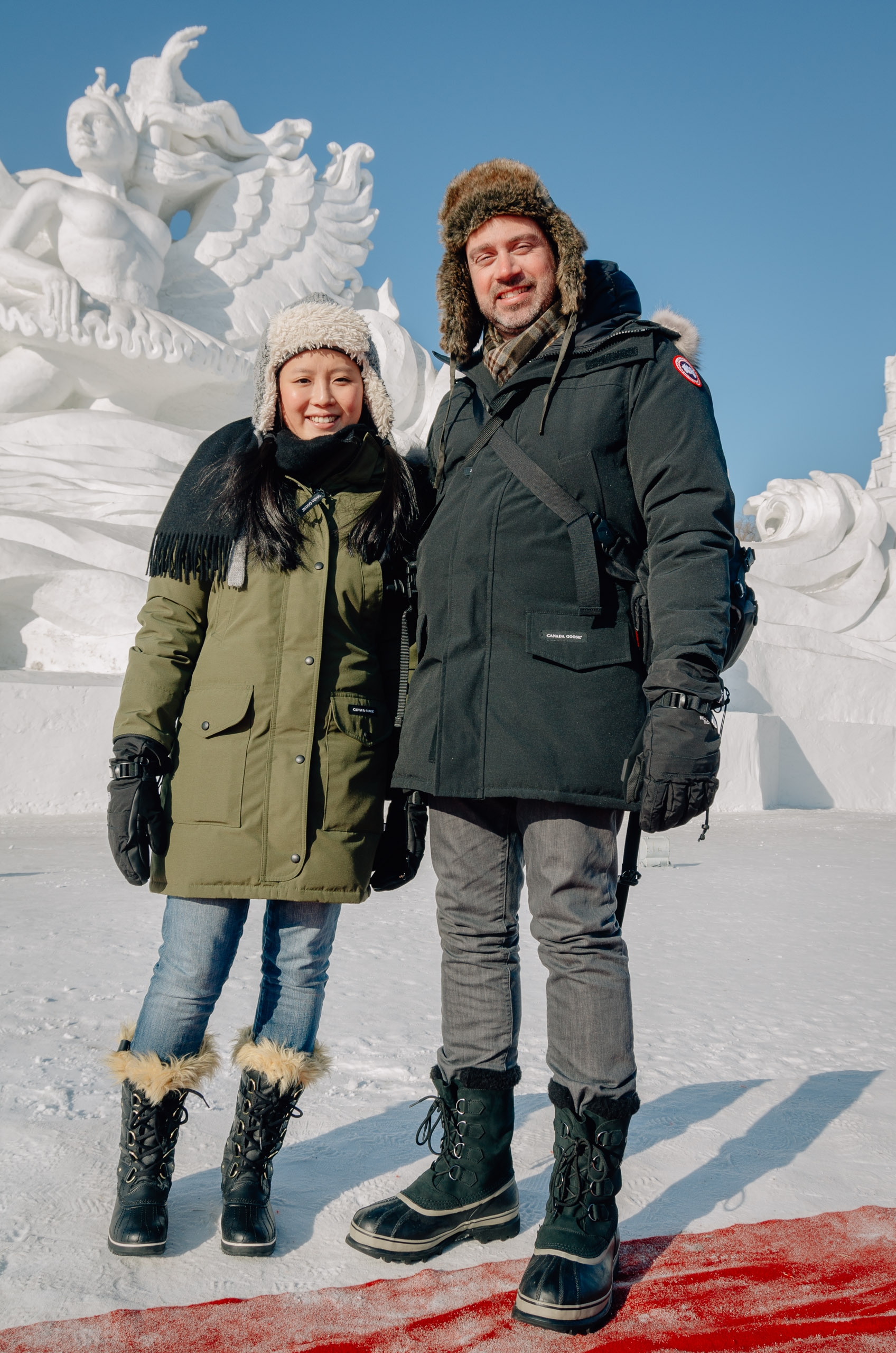
Jessica and I in front of the giant snow sculpture
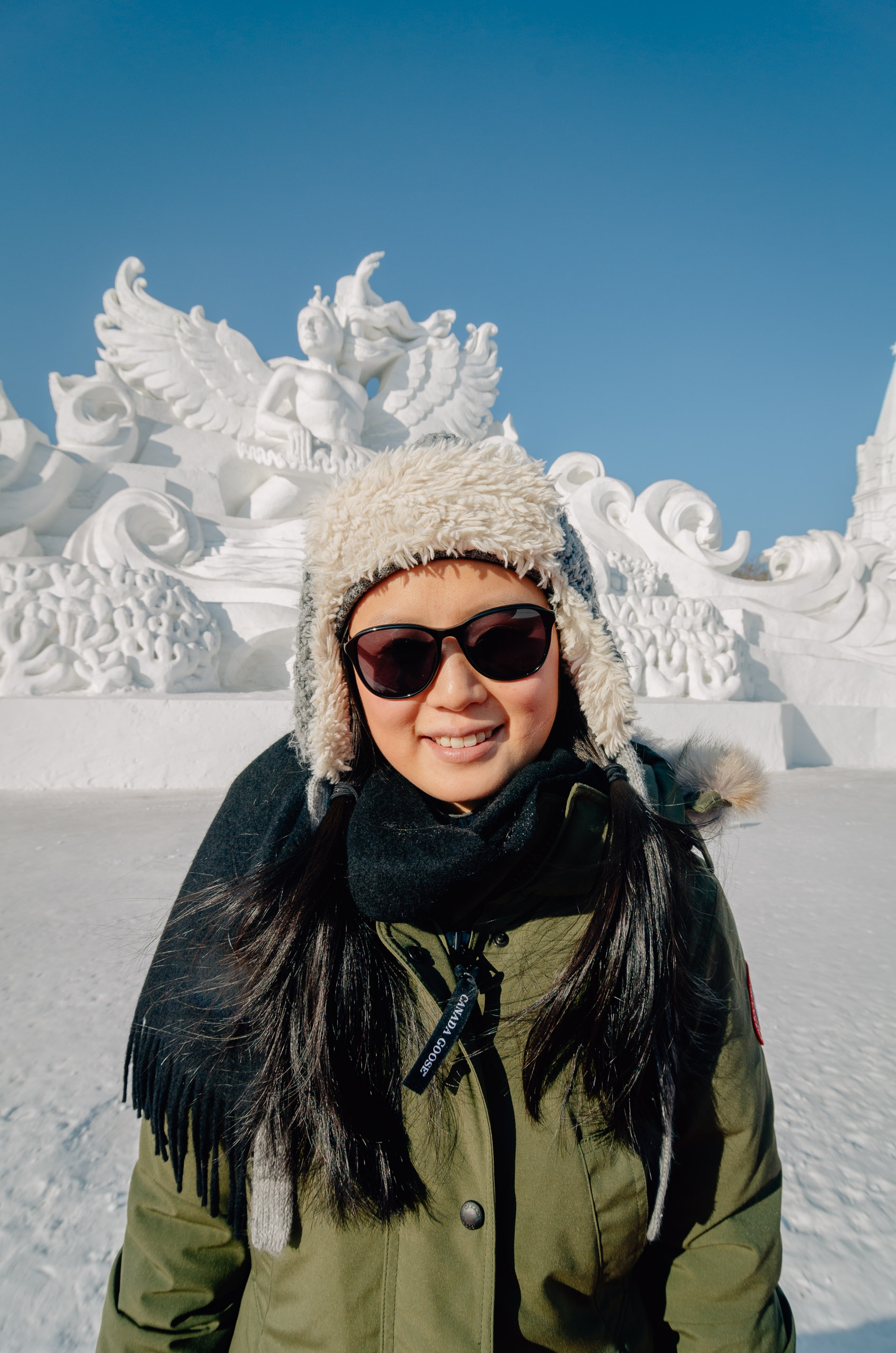
Jessica at the snow sculpture
Luckily our hotel had a 4:00PM checkout, so we were able to relax a bit before heading to the airport for our flight back to Beijing. That night we stayed at a hotel in the airport as we had a early flight to Taipei the next morning.
The Harbin experience was certainly unique, and enlightening. Most visitors to China see Beijing, the center of Government, or cosmopolitan Shanghai, but rarely see what China is like most everywhere else. Fresh off the Olympics in 2008 and the World Expo in 2010, Beijing and Shanghai definitely put China's best foot forward. Harbin by contrast, while not a dumpy backwater, was definitely rough around the edges. The town seems unaccustomed to the crowds the Festival is bringing each year, and its tourist facilities have a long way to go.
Driving into Harbin, you see the China that has economists worried. The centerpiece of China's economic growth lately has been construction; mostly infrastructure projects paid for by the Central Bank's enormous annual trade surplus, and massive investments in speculative real estate driven by inexpensive loans and land development policies. The roads into Harbin were immaculate and huge, with 6 lanes of traffic in either direction and not a car in sight. Bridges, overpasses, intersections, decorative fountains and parks looked brand new and unused. Just outside of town we drove by literally hundreds of high-rise apartment buildings that were all built in the last three years, and with just as many under construction nearby. For miles in any direction you could see row after row of 50 and 60 story buildings, each containing hundreds if not thousands of apartments, and every building was completely dark against the night sky, entirely unoccupied. It was the most surreal, post-apocalyptic thing I've ever seen.
An apartment in one of these buildings goes for about 10,00RMB, or $1,500USD. That's about 5 years' salary for an average middle class Chinese worker. It's inconceivable that any of this is financially solvent, but as long as the Central Bank keeps pumping billions in inexpensive loans for construction, such projects will likely continue. It's rare to actually see a real estate bubble, but I really don't know how else to describe it.
Before we left for the airport, I took this HDR photo of the Harbin sunset out the dirty window of our hotel. If you open the enlarged photo and look at the horizon, you can see a lot of empty buildings, and I would think a lot of looming trouble.
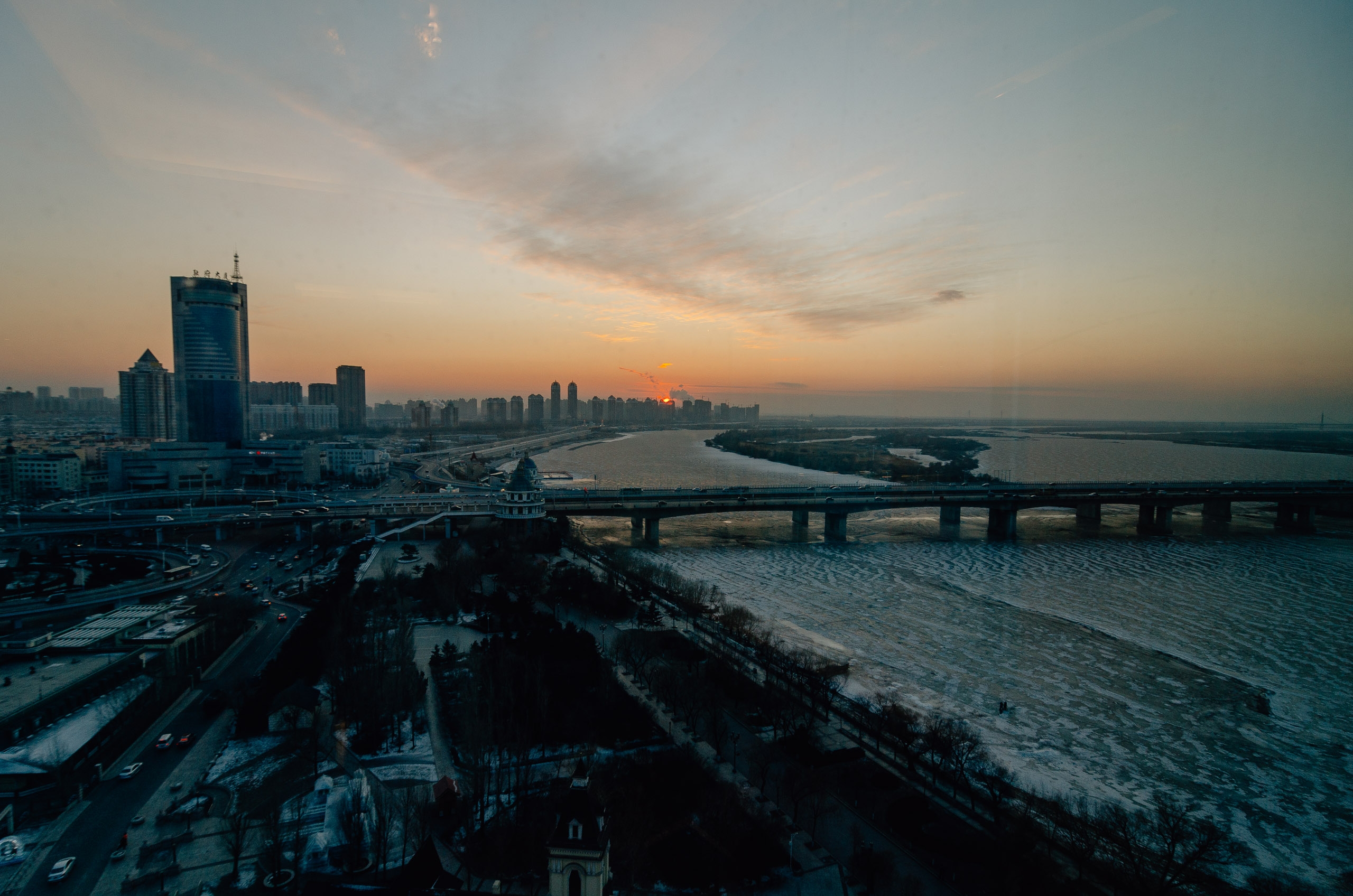
An HDR photo of the Harbin sunset taken through a dirty hotel window
WHERE WE STAYED
Shangri-La Harbin: The club level is sorta worth it. Good location for attending the event: The Shangri-La Harbin
WHERE WE DINED
Shang Place: Traditional Chinese cuisine in the hotel: The Shang Palace
Ice Palace Restaurant & Bar: Seasonal hot pot restaurant and bar made entirely of ice (at the hotel).
Coffee Garden: Western-style coffeeshop in the hotel: The Coffee Garden